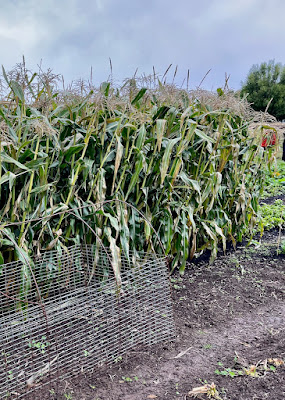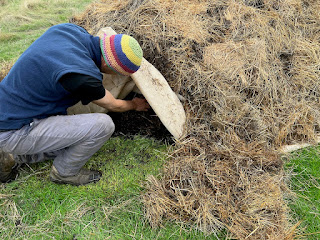Less determined people might have cancelled the visit to Little Farm Margate after a night of heavy rain and a forecast of more, but after two false starts earlier in the season, both hosts and we were totally determined that this visit go ahead. We are so glad we persisted because this food garden visit was one of the highlights of the 2022-2023 season. And the rain decided to stop spoiling things and went away!
Hosts Marcus and Anna (below) began to develop 'their rocky cow paddock with heavy soil' (their words) just three years ago, but in that time they built a house (well, they were involved in the built a lot more than they ever envisaged), a dam, a studio, and, last but not least, a truly impressive market garden.
They now sell veggie-boxes directly to customers and also supply a local grocer, and with that under control there are plans to add two large grow-tunnels this winter for more heat-loving crops and improve drainage across the garden. Yes, it is hard work, but Anna and Marcus are proving that great results can be achieved if you have a vision and the determination to get there.
Walking around this market garden we found a wide variety of crops and most of them looked 'healthy and happy' in spite of the challenging La Niña season. This is due to Marcus and Anna's gardening methods that centre around soil, weeds and pest control.
Soil - Focus on microbial soil health. Soil structure and soil biology are preserved by using the no-dig method. Soil is not left uncovered. Soil is aerated with a broad fork. Soil compaction is avoided by strictly only walking on paths. Plants are cut off at soil level, leaving the roots to compost away in situ. Compost and complete organic fertiliser are put on top of soil so they can be taken into the soil by worms etc. Green manures are used to feed the soil.
Weeds - Weed regularly with a long-handled weeding tool. Always get on top of weeds before they seed. High caution around introducing soil and weed seeds from elsewhere. Layers of compost on top of soil to help weed suppression. Beds are narrow (up to 75cm), so all weeding can be done from the pathways in between.
Pest control - Give all plants the strength to fight any pest that arrives. Get rid of sickly plants before they cultivate pests. No poisons of any kind are used.
Here are some of the crops that Anna and Marcus are currently growing:
On the left Yukina Savoy (a leafier version of Tatsoi) and on the right Kohlrabi.
Two varieties of Egg Plant (aubergines). Very impressive, given the lack of sun and warmth this summer!
Early Jalapeños chilli on the left - they removed the tops of stems, so the plants focus on ripening the capsicums that are there rather than forming new ones. On the right large Beefsteak tomatoes. Elsewhere in the garden we found Roma and Black Cherry tomatoes. Not surprisingly these were all late this season. At present they pick tomatoes early and ripen them inside. Next season they hope to have them in a large grow tunnel, warmer and no damage by birds.


Very healthy high corn stalks (on the left) and wonderfully green Napa cabbage (on the right) . Until last week these were netted to keep cabbage white butterfly out. Marcus and Annay don't grow brassicas over summer because there are too many other interesting summer crops that fill their garden.
The plant above looks a bit like dandelion, but it actually is a relative of chicory - Puntarelle. It is a bitter vegetable from Southern Italy that is traditionally made into a salad with anchovy vinaigrette.
Other interesting Italian vegetables they grow are brassicas like Spigarello and Romanesco, and endives like Radicchio treviso. Marcus and Anna buy these seeds from
The Italian Gardener (
https://theitaliangardener.com.au/).
Another unusual crop that caught my eye was Tomatillos (see blog post
Fruit and Vegs from South America on the Food Garden Group blog). It is the great diversity of crops that makes buying vegie-boxes from
Little Farm Margate (see their Facebook page) so rewarding.
Elsewhere in the garden were cucumbers (prolific this season Anna told us), cauliflower, broccoli, carrots, peppers, capsicums, silverbeet, lettuce .... the list goes on and on.
An Onga pump is used to irrigate water that comes from a dam higher up the property. This season irrigation was only needed in the January - March period.
A broad fork for aerating soil and a long-handled weeding tool were bought from
ActiveVista Australia in Longley.
Marcus took a group of us around the garden and talked about crops and the day-to-day work in the garden. Anna took another bunch of us to the frog pond next to the garden and talked about their gardening methods and insects. The two groups then changed presenter, so we all had a chance to hear the full story. This worked really well!
Anna explained that insects, birds and frogs are an important part of the farm - their main line of defence against pests. They created a pond, invited local frogs (hopping pest eaters) to move in, and after a while they did.
An area with carefully chosen flowering plants was created to attract all kinds of beneficial insects to the garden. Anna explained that particular plants attract particular insects. We hope to have a new Food Garden Group blog post on the subject in the not too distant future.
We also talked about the fact that not every pest needs instant action from us. There was an aphid infestation in the only big tree on the property. After a few weeks predating insects arrived (ladybirds) and the problem solved itself.
Nearby were two bee hives with more flowering plants and a few wind breaks.
The market garden is bordered by floppy fences (for more info on these see FGG blog post
Wildlife and Food Gardens) and electric fences. The electric fences were bought from Hollander Imports. The
electric fence is charged with a solar 'Fence Energiser' from Thunderbird Electric Fencing Systems (https://thunderbird.net.au/) . Weed mat under the fence helps keep grasses away from the fence line.
Together with an effective gate this setup does a great job. The wildlife took just a few nights to get used to the fence being there. Now they no longer try to get into the garden. The poos around, but not in, the garden show that there is plenty of wildlife around. Creating a robust deterrent so wildlife realises it is futile trying to intrude is working very well here.
Marcus showed me a large compost heap consisting of hay, kelp, manure and lime, covered with a tarp (to suppress weeds) and hay on top to keep moisture and heat in. In the photo he is checking the heat of the heap. He now makes his own compost rather than buying compost which he found to be too alkaline and woody.
Marcus and Anna's enthusiasm, knowledge and preparedness to share it all meant that not only was there plenty to see, but everyone also came away with plenty to consider for their own food garden.
Thanks everyone for your morning tea and produce table contributions, and in particular for not bringing any soil to the produce table. Not having any aggressive weeds at Little Farm Margate makes a big difference for Marcus and Anna.
This was a great visit! Many thanks to Anna and Marcus, and we are grateful that we did not end up very wet on this last food garden visit of the 2022 - 2023 season.


















No comments:
Post a Comment
Note: Only a member of this blog may post a comment.